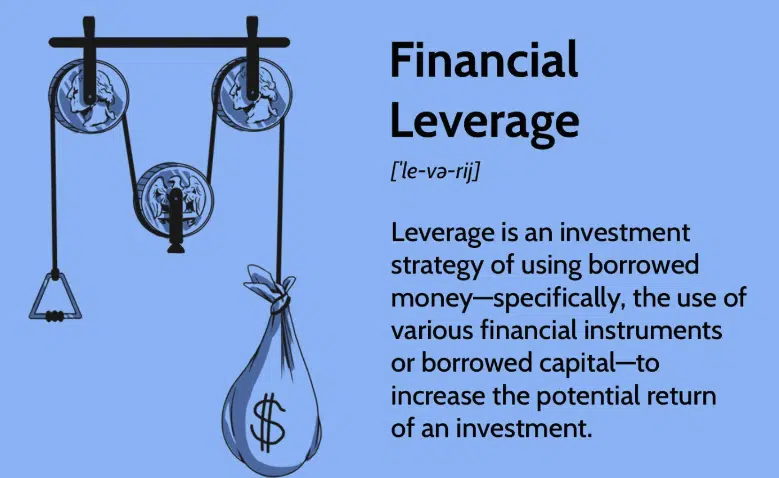TLDR
Leverage trading is where traders borrow money to increase their market exposure. This allows them to control much larger positions than possible with just their capital. While this magnifies profits, it also exposes your account to increased risk.
However, by learning how leverage works, it can be used to make considerable gains in record time. This guide will tell you exactly what leverage is, the risks and benefits, and how to start with leveraged trading.
What does leverage mean?
In the trading context, leverage refers to borrowing money to create a more significant position size.
Leverage trading can multiply your profits while exposing you to greater market volatility and risk. Those without a deep understanding of leverage can quickly lose their entire investment. However, leverage isn’t inherently risky, especially if you understand how and what you’re doing.

When you increase your amount using leverage, you’re essentially borrowing money from a broker to invest more money. If the financial asset’s price goes up, you net greater profits. If the price drops, you lose more money and possibly all the money you invested. Leverage trading only requires you to put down a fraction of your position’s value. A third-party broker or exchange provides the remaining capital.
Though ‘leverage’ is often associated with financial markets like stocks and forex markets, borrowing funds to enter a larger trade exists across almost every trading market and cryptocurrency market.
How does leverage work in crypto?
Leverage in crypto works the same as it does in other markets. However, high-leverage trading opportunities are far more common in cryptocurrency markets. Exchanges like Binance offer up to 125x leverage on certain products.
This means the exchange will lend you money for every $1 in your account to trade a position worth $125. Depending on the platform, you may have access to various leveraged trading products. These include derivatives contracts, which are contracts pegged to an underlying asset—or leveraged tokens, which we’ll discuss in more detail later in this guide.

As mentioned above, leverage trading increases your position size, but another reason to use leverage is to enhance capital liquidity. For instance, if you have $1000, you could trade with 10x leverage to open a $10,000 position.
However, your entire $1000 is inaccessible for other trades or hedge existing positions. If you put down $500 at 20x leverage, you can open the same $10,000 trade with half your initial capital.
Whether you’re creating a long or short position in financial assets, leverage can be beneficial for increasing potential profits. However, as your leverage rises, so does your risk exposure.
What is the leverage ratio?
The leverage ratio represents the extent to which your trade size is amplified. For instance, a 10x leveraged trading position, with $1000, can be used to open positions worth $10,000. This is expressed as a 10:1 leverage ratio.
Cryptocurrency markets offer some of the highest leverage ratios accessible to investors. That is one of the main reasons crypto trading is so popular. High leverage makes generating significant profits worth more than collateral from even small market movements possible.

With crypto markets being infamously volatile, it’s no wonder trading with leverage is so popular among digital asset enthusiasts.
Leverage ratios also tell you about the exchange or broker’s margin requirements. For example, a 10:1 leverage ratio means putting 10% of the position’s notional value as collateral.
Most exchanges limit the leverage provided to new accounts until they’ve made a few trades. Additionally, while higher leverage can lead to greater profits, it is easier to run into margin calls as leverage rises.
What is a margin call?
Margin calls happen when collateral in your account exceeds the minimum amount needed to maintain leveraged positions. In such cases, the exchange will ask you to deposit more collateral or liquidate your collateral assets until you meet margin requirements.
Understanding Margins
As mentioned above, the amount of collateral required to access leveraged products is called its margin. A 100x leveraged position represents a 1% margin requirement, meaning you must deposit $100 for every $10,000 position. That is considered a very high margin.

Margin calls are much easier to understand when you look at things from the exchange’s perspective. Say you deposit $1000 at 10x leverage to open a long position on BTCUSD. The exchange lends you $9000; your leverage account is now worth $10,000.
Consequences of Margin Call
However, if Bitcoin fell by 1%, your position’s value would fall to $9900. In this case, you’ve only lost $10, but the lender has technically lost $90.
The exchange will always prioritize the safety of the lender’s funds so that they will do one of two things:
- Ask you to deposit more collateral to maintain your leveraged trading position or
- Seize your collateral until it matches the margin requirements
Margin Call Example
The problem with 10x leverage is that Bitcoin only needs to fall by around 10% for the exchange to liquidate your collateral assets. That is because they will always prioritize repaying the lender, even at the expense of your funds.
In the example above, a 10% drop would cause your margin account value to drop to $9,000. The lender’s funds would hold up the entire position, meaning you’d own 0%. This tolerance goes down as leverage rises. This means that at 100x leverage, even a 1% drop in position value will force the exchange to seize your collateral.
Impact of Margin Calls
These are what’s known as margin calls, and they can be devastating for overleveraged positions caught in a bad trade. For this reason, FINRA, the US regulatory authority for securities, requires investors to keep a minimum 25% maintenance margin. Some brokers demand even higher maintenance margins of up to 40%.
Margin calls are far more likely to occur during volatile market conditions, an all too familiar environment for crypto traders. For this reason, many crypto traders will deposit more than the required initial capital before entering into leveraged trades.

The difference between margin and leverage
‘Margin’ and ‘leverage’ are two terms often used interchangeably, but subtle differences exist between them. Margin refers to the minimum collateral needed to open a leveraged position, while leverage tells you how much your position size will be amplified.
Practically, margin and leverage are two sides of the same coin. A 10% margin requirement equates to 10x leverage. Margin requirements vary based on the leverage being offered. Factors like market risk, asset type, and any additional terms and conditions the lender sets. Many brokers and exchanges offer a leverage trading calculator on their platforms, but it’s easy enough to figure out without one.
Getting Started With Leverage Trading on Binance
Like any platform that offers leverage, Binance requires you to deposit part of the total position size you want to open.
This deposit is known as the initial margin, and for new accounts, Binance lets you access up to 10x leverage. This means you can open a $10,000 position using just $1000.
If you don’t have a Binance account, you can easily get one by clicking the [Get Started] button.


More details
Binance is a great combination of low fees, deep liquidity and multiple cryptocurrencies and trading pairs. We have tested every aspect of it and it STILL holds its reign as the top exchange in the world. In our view, it is the perfect crypto exchange for both newbies and advanced traders alike.
-
Biggest exchange in the world.
-
Industry's lowest trading fees.
-
Advance trading options like leverage trading.
-
600+ crypto options, 150+ for the US.
-
Lucrative on-site staking options.
-
Hiccups in account verification.
-
Less regulated than some competitors.
-
The corporate structure is not transparently.
Step 1: Set up your leverage trading account
Once you’ve created and logged into your Binance account, go to your account dashboard, where you can see the balances of all your trading accounts.

To open a margin account, click [Margin] under the [Wallet] section in the dashboard after completing the KYC process and verifying your identity.

2-factor authentication is also mandatory for opening a leveraged account on Binance. It is important to note that countries on the platform’s blocklist do not have access to leverage trading.

Complete the margin trading quiz (if you’ve made it this far through this guide, you’ll ace this), and activate your margin account. You can now transfer funds from your standard Binance wallet to your margin trading wallet.
Step 2: Create leveraged trading positions

When you’re done transferring funds to your margin trading wallet, you can use it as collateral to borrow more funds.
You need to make a selection to borrow a specific cryptocurrency, say BTC.
At 5x leverage, you can borrow 4 BTC as long as you have at least 1 BTC in your margin account. Once the borrowed funds have been credited, you can trade using those funds as usual through OCO and Stop-Limit orders.
You can track your account’s available leveraged trading pairs by visiting the [Margin Fee page.]

You can also view some stats about your margin account, such as the interest rate (updated hourly) and your margin and risk levels based on your debt-to-collateral ratio. You can even check your margin account’s status from the [Margin] tab on the Wallet Balance page.

If your margin level falls, you will receive margin calls reminding you to deposit more collateral or repay part of your loan. If your margin levels drop too low, Binance will automatically liquidate your holdings at the current market price to repay the loan.
You can click on [Positions] for more information about existing positions.
Step 3: Manage leverage trading risk
Risk plays a considerable role in leverage trading and, if not managed correctly, can lead to untold losses. Managing your risk involves squaring off positions held for too long and ensuring you repay your broker as needed.
To clear off your debt on Binance, select the [Repay] tab after clicking on the [Borrow/Repay] button.
When ready, click [Confirm Repayment] after choosing the relevant token and amount.

The total amount due includes the amount borrowed plus any interest owed. Additionally, you can only use the same cryptocurrency you borrowed to repay the load, so ensure you have the necessary funds to continue.
You always have the option of moving funds from your margin wallet to your spot wallet without any fees, but note that any open positions become riskier as the funds in your margin wallet decrease.
If risk levels get too high, Binance may liquidate your assets. Closely monitoring your margin levels is vital to managing your leverage trading risk.
Examples of leveraged trading
To better understand leverage trading, let’s look at two examples covering how both long and short positions are impacted by leverage. You must deposit collateral into your leverage trading account to borrow funds and begin trading with leverage.

For the following examples, say you decided to trade $1000 at 20x leverage, giving you a position size worth $20,000. This means you’ll have to deposit an initial capital of at least $1000. Still, some exchanges will ask you to deposit additional funds as a maintenance margin when the market moves against your position.
Suppose this happens, and your account value drops below the maintenance margin required. In that case, the exchange will ask you to deposit more collateral or liquidate your position until the maintenance margin threshold is achieved.
Margin trading a short position
When you short an asset, you’re essentially borrowing assets to sell at a higher price and repurchasing them once the market falls to repay the lender. Assuming Bitcoin trades at $20,000 apiece, you could borrow 1 BTC and immediately sell for a market value of $20,000.
If Bitcoin’s price fell to $16,000, you could use your $20,000 to purchase 1.25 BTC, 25% more than you borrowed. 1 BTC goes back to the lender, leaving you with 0.25 BTC profit (minus the interest on the loan), which works out to around $4,000 profit.
However, if Bitcoin’s value rose to $21,000, you’d need an additional $1000 to repurchase 1 BTC at market price and repay the lender.
If you open a 20x leveraged short position, things work similarly, except the broker or exchange borrows assets outright on your behalf.
Margin trading a long position
When you open a long position, you’re buying an asset with the expectation that it’ll be appreciated in value. If you buy 1 BTC at $20,000, and Bitcoin rises by 5% to $21,000, you’ve made a $1000 profit. However, you’d need to have $20,000 to buy the asset in the first place.
Instead of purchasing the asset with your funds, depositing just $1000 to open a 20x leveraged long position gives you the same exposure to Bitcoin’s price.
If the stock market moves up by just 5%, you’ll have gained 100% profit on your $1000 investment. However, this exposes you to increased risk, just as with leveraged short positions.
How much leverage should I use?
The concept of leverage has existed for a long time. Historically, brokers have offered dangerously high leverage of up to 400:1. This allowed traders to open positions worth $100,000 with a margin of just $250.
However, after the global financial crisis of 2008, regulators quickly controlled the amount of leverage brokers could offer, limiting most traders in traditional financial markets like stock trading to a maximum of 50x leverage.
Sticking to smaller leverage ratios is safer if you’re starting with trading. Experienced traders recommend using leverage of no more than 5x; before deciding the maximum risks of leverage you should take, it’s crucial to understand how much you’re willing to risk and the impact of high leverage ratios on margin calls.
How to leverage ratio impacts margin calls.
As discussed earlier, margin calls are more easily triggered at higher leverage ratios.
Imagine you have $10,000 in your leverage trading account and decide to open a long position at 50x leverage, creating a position worth $500,000. For the exchange to consider liquidating all of the funds in your account, your position would only need to fall to $490,000, or around 2%.
Instead, if you used your funds to open a 5x leveraged long position worth $50,000, the market would need to fall to $40,000 or 20% for you to receive a margin call. A 20% drop in value is far less likely than a 2% drop, but the potential amount lost in either case is the same.
This relationship between leverage and the risk of margin calls is crucial to understand before working with higher leverage ratios since even the slightest market movements can impact your position.
Deciding your maximum leverage
There are no universal rules for the amount of leverage you should use. Depending on their risk appetite and their relationship with their broker, many traders have different opinions on how much leverage is too much.
This is something you’ll need to find out for yourself, but regardless of how much you decide to use, here are some tips to keep in mind:
- Use limit orders, stop-losses, and trailing stops to protect your capital and limit the downside. Learning these advanced order types and how they protect your account from sudden market movements is essential to becoming a successful leverage trader, especially when the market moves against you.
- Don’t use more than 1-2% of your available capital to initiate a leveraged trade. For example, if you have $5000, don’t use more than $50 to create a margin position. This ensures you have enough capital to meet margin calls, even on high-leverage trades.
- Start somewhere comfortable: If the thought of losing your entire position from the slightest market movement makes you queasy, stick to using lower leverage ratios. As you become more experienced with leverage, your comfort level will adapt.
Risk Management in Leveraged Trading
Risk management is essential to trading with leverage, protecting you from runaway losses, and putting you in a better position to take advantage of profitable opportunities. While there’s no such thing as no risk management or too much risk management, here are a few of the most noteworthy methods to manage your leverage trading risk.

Determine your risk for each trade.
Before selecting the amount of leverage you want to use, determine how much of your capital you’re willing to risk per trade. Most experts advise using no more than 3% of your capital on a single trade, regardless of how enticing it may seem. No trade can provide guaranteed outcomes, and using too much leverage can put your brokerage account at increased risk levels, especially in more volatile markets.
Learn the advanced order types.
From limit orders and stop losses to trailing stops and take-profit orders, learning what each order type does, how they’re used, and implementing them into your trading and investment strategy is vital to managing your leverage trading risk. Stop losses help you limit losses when the market goes against you, while take-profit orders secure your profits at the right price points, ensuring you can repay your debts. These are especially useful for high-leverage trades, where even the slightest market movements can profoundly impact.
Practice with paper trading
Using leverage as an inexperienced trader can be quite daunting. Still, you can test your strategies on a live market by paper trading (using a stock trading or simulator) without risking a dime. Of course, you can’t profit from paper trading, but it will give you the practice to control your leveraged positions when you start trading for real.
Hedge your bets
Don’t put all your eggs in one basket unless you’re prepared to lose it all. By diversifying your investments, you can decrease your risk exposure and increase potential profits from your margin account. Additionally, this means that profits from winning trades can be put towards paying off losses from failed transactions. Though this may mute your earnings in the short term, this ensures your account continues to grow with time. If you have the opportunity, opening an inverse position on the derivatives market can also help protect your account when a trade goes wrong.
Conclusion
As previously mentioned, due to its high volatility, there’s a massive demand for leveraged trading platforms within the cryptocurrency market. If you’re starting with leverage trading, it’s important to pick a platform with the features you need while also being beginner-friendly.
Binance is the world’s largest and most popular leverage trading platform for cryptocurrencies, offering the widest selection of trading pairs and up to 10x leverage for new accounts. The platform has a strong reputation and provides beginners with a world-class user interface to start on their leverage trading journey. It even has a mobile app to monitor positions and manage your margin account.
Of course, other platforms exist, such as Kraken, which offers low-fee margin trading at up to 5x leverage for new accounts. However, the user interface may confuse newer traders, and Kraken doesn’t have as wide a selection of tokens as Binance. Another option is Coinbase, though fees are much higher, and not all countries are supported.
Utilizing leverage in trading entails securing additional funds from a broker to amplify your position size, potentially enhancing both your market exposure and opportunities for profits.










